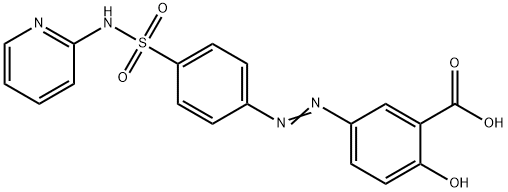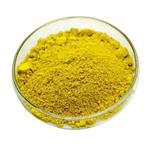
Sulfasalazine
- Product NameSulfasalazine
- CAS599-79-1
- CBNumberCB0181156
- MFC18H14N4O5S
- MW398.39
- EINECS209-974-3
- MDL NumberMFCD00057363
- MOL File599-79-1.mol
Chemical Properties
| Melting point | 260-265 °C (dec.)(lit.) |
| Boiling point | 689.3±65.0 °C(Predicted) |
| Density | 1.3742 (rough estimate) |
| refractive index | 1.6000 (estimate) |
| storage temp. | Keep in dark place,Sealed in dry,Room Temperature |
| solubility | NH4OH 1 M: 50 mg/mL, clear, red |
| pka | pKa 0.6(H2O t = 20 I < 0.001) (Uncertain);2.4(H2O t = 20 I < 0.001) (Uncertain);9.7(H2O t = 20 I < 0.001) (Uncertain);11.8(H2O t = 20 I < 0.001) (Uncertain) |
| form | powder |
| color | Orange |
| Water Solubility | <0.1 g/100 mL at 25 ºC |
| Merck | 14,8942 |
| BRN | 356241 |
| BCS Class | 2,4 |
| Stability | Stable for 1 year from date of purchase as supplied. Solutions in DMSO may be stored at -20° for up to 1 month. |
| InChIKey | NCEXYHBECQHGNR-QZQOTICOSA-N |
| CAS DataBase Reference | 599-79-1(CAS DataBase Reference) |
| FDA UNII | 3XC8GUZ6CB |
| IARC | 2B (Vol. 108) 2016 |
Safety
| Symbol(GHS) |

|
|||||||||
| Signal word | Danger | |||||||||
| Hazard statements | H317-H334 | |||||||||
| Precautionary statements | P261-P272-P280-P284-P302+P352-P333+P313 | |||||||||
| Hazard Codes | Xn | |||||||||
| Risk Statements | 42/43 | |||||||||
| Safety Statements | 22-29/56-45 | |||||||||
| RIDADR | 3077 | |||||||||
| WGK Germany | 2 | |||||||||
| RTECS | VO6250000 | |||||||||
| F | 8 | |||||||||
| HS Code | 29350090 | |||||||||
| Hazardous Substances Data | 599-79-1(Hazardous Substances Data) | |||||||||
| Toxicity | LD50 oral in rabbit: > 7500mg/kg | |||||||||
| NFPA 704: |
|



